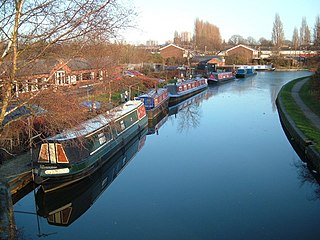
The Wyrley and Essington Canal, known locally as "the Curly Wyrley", is a canal in the English Midlands. As built it ran from Wolverhampton to Huddlesford Junction near Lichfield, with a number of branches: some parts are currently derelict. Pending planned restoration to Huddlesford, the navigable mainline now terminates at Ogley Junction near Brownhills. In 2008 it was designated a Local Nature Reserve.

Cannock is a town in the Cannock Chase district in the county of Staffordshire, England. It had a population of 29,018. Cannock is not far from the nearby towns of Walsall, Burntwood, Stafford and Telford. The cities of Lichfield and Wolverhampton are also nearby.

Rugeley is a market town and civil parish in the Cannock Chase District in Staffordshire, England. It lies on the north-eastern edge of Cannock Chase next to the River Trent; it is situated 8 miles (13 km) north of Lichfield, 10 miles (16 km) south-east of Stafford, 5 miles (8.0 km) north-east of Hednesford and 11 miles (18 km) south-west of Uttoxeter. At the 2021 Census, the population was 24,386.
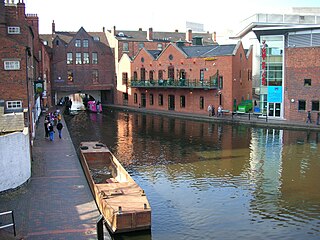
Birmingham Canal Navigations (BCN) is a network of canals connecting Birmingham, Wolverhampton, and the eastern part of the Black Country. The BCN is connected to the rest of the English canal system at several junctions. It was owned and operated by the Birmingham Canal Navigations Company from 1767 to 1948.
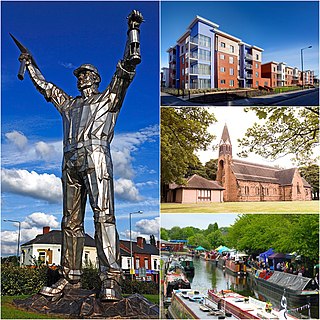
Brownhills is a town and former administrative centre in the Metropolitan Borough of Walsall, West Midlands, England. A few miles south of Cannock Chase and close to the large Chasewater reservoir, it is 6 miles (9.7 km) northeast of Walsall, a similar distance southwest of Lichfield and 13 miles (20.9 km) miles north-northwest of Birmingham. It is part of the Aldridge-Brownhills parliamentary constituency and neighbours the large suburban villages of Pelsall and Walsall Wood. It lies within the boundaries of the historic county of Staffordshire.

Cannock Chase is a local government district in Staffordshire, England. Its council is based in the town of Cannock; other notable towns are Rugeley, Bridgtown and Hednesford. The district covers a large part of the Cannock Chase Area of Outstanding Natural Beauty, from which it takes its name.
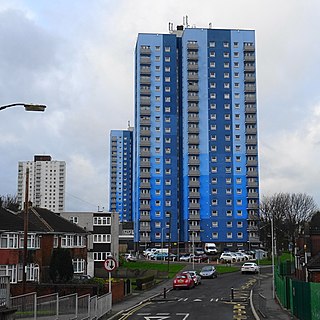
Wednesfield is a town and historic village in the City of Wolverhampton, West Midlands, England, It is 2 miles (3.2 km) east-northeast of Wolverhampton city centre and about 10 miles (16 km) from Birmingham and is part of the West Midlands conurbation. It was historically within the county of Staffordshire.

The Chase Line is a suburban railway line in the West Midlands region of England. It runs from its southern terminus, Birmingham New Street, to Walsall, and then Rugeley in Staffordshire, where it joins the Trent Valley Line. The name of the line refers to Cannock Chase which it runs through at its northern end.

Great Wyrley is a large village and civil parish in Staffordshire, England. It is coterminous with the villages of Landywood and Cheslyn Hay in the South Staffordshire district. It lies 5.5 miles north of Walsall, West Midlands. It had a population of 11,060 at the 2011 census.

Essington is a village and civil parish in South Staffordshire, England, located near the city of Wolverhampton and towns of Walsall, Bloxwich, Cannock and Brewood. The villages of Cheslyn Hay, Great Wyrley, Coven, Penkridge and Featherstone are also nearby. The village forms part of the Staffordshire/West Midlands border.

Landywood is a small village in Staffordshire, England. Landywood forms part of the parish and village of Great Wyrley, and together with Great Wyrley and Cheslyn Hay, forms a community with a combined population in 2001 of almost 20,000. For the population as taken at the 2011 census see Great Wyrley.
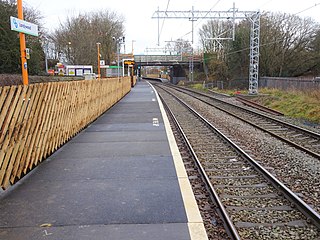
Landywood railway station is situated in the village of Landywood in Staffordshire, England. As well as Landywood, the station also serves the adjacent villages of Cheslyn Hay and Great Wyrley. The LNWR also operated an earlier halt at Landywood which closed on 1 January 1916.

Cheslyn Hay is a former mining village and civil parish which is contiguous with Great Wyrley and Landywood in Staffordshire, England. It is situated within the South Staffordshire district some 3 miles south of Cannock, 7 miles north of Walsall, 8.5 miles northeast of Wolverhampton and 12.5 miles south of the county town of Stafford. The West Midlands county border lies 2 miles to the south.
The South Staffordshire Railway (SSR) was authorised in 1847 to build a line from Dudley in the West Midlands of England through Walsall and Lichfield to a junction with the Midland Railway on the way to Burton upon Trent, with authorised share capital of £945,000. It was supported by the newly-formed London and North Western Railway (LNWR) and the Midland Railway, giving each company access to important areas. It completed its main line in 1849. As collieries in the Cannock region rose in importance, it built a second main line from Walsall to Rugeley, as well as numerous short spurs and connections to lines it intersected. Colliery working in the Cannock area expanded enormously, and mineral traffic carryings increased in step.
Wyrley and Cheslyn Hay railway station served the villages of Great Wyrley and Cheslyn Hay in Staffordshire, England, between 1858 and 1965.

Norton Canes is an industrial village, civil parish and ward of Cannock Chase District, in Staffordshire, England.
Little Wyrley is an English hamlet in the county of Staffordshire, that forms part of Norton Canes civil parish and the Cannock Chase district. In 1870-72 it had a population of 61 as recorded in the Imperial Gazetteer of England and Wales.
Cannock Chase Radio FM is a community radio station, broadcasting to Cannock Chase District in Staffordshire, England. The station's tagline is 'The Greatest Hits and So Much More!' and it has been broadcasting online since 15 November 2014 from studios in Bridgtown, Cannock.

North Lanes (Lime Lane) is an area of Norton Canes, in the Cannock Chase District of Staffordshire. The area is rural, and forms a large part of Norton Canes's greenbelt. It is the location of the former colliery from where a canal basin of the Cannock Extension Canal is located, and sits above multiple mineshafts. The name is historically Lime Lane but appears as North Lanes on modern maps. The area is mostly made up of winding roads, farmland and common land. The Cannock Extension Canal here is a Cannock Extension Canal due to the presence of Floating Water Plantain. As well as its proximity to Little Wyrley, Brownhills West and Norton Canes. There are two lots of service stations as well as a social club and industrial estates.


















